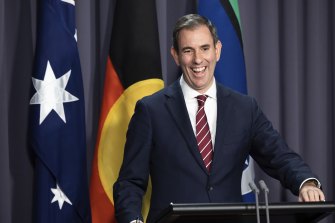Treasurer Jim Chalmers will hand down a “cost-of-living” package in his October budget, but it is unlikely to contain measures in addition to those promised during the election campaign amid concerns about the state of the nation’s finances.
Promises around childcare, energy, medicines and wages will be pulled together to form the central planks of the package, which is likely to be announced just as inflation nears its forecast peak of 6 per cent.
Treasurer Jim Chalmers says the cost of living is the focus of the new government.Credit:Alex Ellinghausen
The Coalition used the March 29 budget to announce $9 billion of cost-of-living measures, including $250 one-off payments to welfare recipients, an increase in the size of the low- and middle-income tax offset and a 22.1¢–a-litre cut in petrol excise, which is due to end in late September.
But inflation figures released soon afterwards showed consumer prices growing much faster than had been expected by both Treasury and the Reserve Bank. So concerned was the RBA that it increased official interest rates during the election campaign.
Chalmers, who will make an economic statement to parliament next month and then deliver his own budget in October, said the cost of living was the focus of the new government.
He said relief for ordinary taxpayers after fuel excise reverted to its normal level would be at the heart of the budget.
“Cost of living will be central to the October budget. What we need to focus on as a new government is the cost-of-living relief that comes in after the former government’s cost-of-living relief runs out,” he said.
“Clearly, if there are ways that we can provide additional support, responsibly, in a cost-effective way, of course, any government would consider that in the lead-up to a budget.”
During the election campaign, Labor promised assistance to families through an increased childcare subsidy. It is working on a submission to the Fair Work Commission’s annual review of the minimum wage and has also promised to drive down energy prices.
Extra relief on top of these core promises is unlikely as Chalmers remains concerned about the state of the budget, which is forecast to show a deficit of $80 billion this year and $78 billion in 2022-23.
But figures from the Finance Department suggest the new treasurer has more money than expected.
To the end of April, the budget was $10 billion ahead of where it was expected to be, showing a deficit of $46 billion for the first 10 months of the financial year. Revenue, largely from company tax, was $3.7 billion ahead of forecasts, while spending was $6.5 billion lower than had been expected.
Deutsche Bank senior economist Phil O’Donaghoe believes the budget is likely to finish this financial year showing a deficit of about $69 billion.
Chalmers said there were growing financial pressures on the budget, which meant it would be difficult to extend the fuel excise reduction beyond the end of September.
“We have said previously, and I’m prepared to say again now, it will be difficult to find the billions of dollars necessary to extend the petrol price relief when it runs out in September. Obviously, we consider the conditions at the time, but I think Australian should consider it unlikely,” he said.
Retail trade figures from the Australian Bureau of Statistics also highlighted the impact of prices on consumers.
Turnover through April was up by 0.9 per cent after a solid 1.6 per cent increase in March.
The bureau noted that the lift in sales was being driven by both increased spending by consumers through restaurants and cafes and by “higher food prices”.
The Morning Edition newsletter is our guide to the day’s most important and interesting stories, analysis and insights. Sign up here.
Most Viewed in Politics
From our partners
Source: Read Full Article



